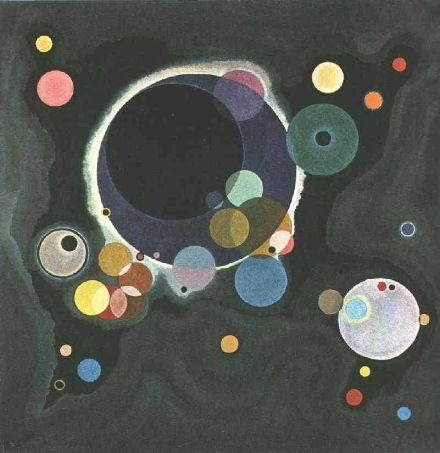Art
About Andrew Cusack
 Writer, web designer, etc.; born in New York; educated in Argentina, Scotland, and South Africa; now based in London.
Writer, web designer, etc.; born in New York; educated in Argentina, Scotland, and South Africa; now based in London. read more
News
Blogs
Reviews & Periodicals
Arts & Design
World
France
Mitteleuropa
Knickerbockers
Argentina
The Levant
Africa
Cape of Good Hope
Netherlands
Scandinavia
Québec
India
Muscovy
Germany
Academica
Epiphany

Pietro Perugino, Adoration of the Kings (Epiphany)
Oil on panel, 95′ x 70′
c. 1476, Galleria Nazionale dell’Umbria, Perugia
Soggy Manhattan
Ah, Manahatta. Even on a day as soggy as this, the Upper East Side still charms me. It also retains a fair number of buildings from the days when New York had higher tastes, mostly to be found between Fifth and Park Avenues. It is a fact to be mourned that we have probably destroyed most of what was good in New York’s built environment. Nonetheless, we should of course be glad for the beautiful things which remain from our great city’s golden age, and thankfully they are not a mere handful.
Stumbling down East 82nd Street this afternoon amongst puddle, gloom, and rain I emerged onto Fifth Avenue to see the beautiful mass of the Metropolitan Museum of Art revealed in all its glory. The façade of the Met has recently been cleaned and glancing at it today, despite the cloud and percipitation, one could almost imagine the year as 1902 when the wing designed by Richard Morris Hunt was completed. This is doubly so because the Metropolitan currently lacks her usual ungainly vexillic adornments pronouncing the exhibits shown in her distinguished galleries. These banners add nothing to the Met’s façade, and if there is a more clever and handsome way of announcing what is within without – and surely there must be – the Museum does not seem to have found it.
Still, the situation is not as reprehensible as across Central Park at the American Museum of Natural History. The AMNH enjoys two façades, one of which commands the view over Central Park West and the park itself beyond. The main portion of the Museum’s Central Park West front is a brilliant triumphal arch which is in fact the State of New York’s monument and memorial to Theodore Roosevelt, President of the United States and Governor of New York during his earthly life. Shamefully, the Museum disrespects this great monument to this great man by covering it in advertising banners akin to those which usually mar the Metropolitan. The American Museum of Natural History should be ashamed of itself for sullying such an august and dignified locale for the purposes of selfish marketing.
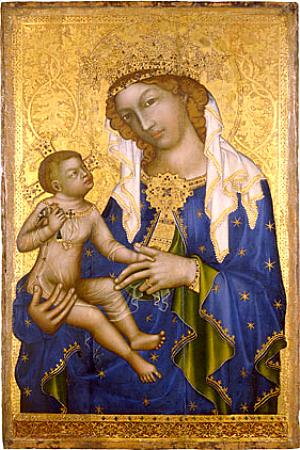
Tempera and gold on panel; 35′ x 23′
Deacon’s Office, Zbraslav/Koenigsaal/Aula Regia
(on loan to the National Gallery, Prague)
What brought me to plod up the splendid elevating staircase of the Metropolitan was to catch – just barely, for this was its last day – the special exhibition entitled Prague: The Crown of Bohemia 1347-1437. I had first gotten wind of this showing flipping through the mail whilst I was still interning at the New Criterion at the end of the summer and duly noted in my diary that though it opened while I was away in Scotland it would still be open upon my return for the Christmas holiday. Anyhow, I finally took advantage of it today and it was much enjoyed. What a remarkable land is Bohemia. The exhibit served only to augment my interest in the country and I must be sure to spend some time there sooner or later.
In addition to the Mother and Child above, the exhibit presented the tabernacle shown below (photographed in its actual home). There were also many, many reliquaries, some of which appeared to still have relics in them. One would have thought a museum’s interest in a reliquary was purely artistic and thus that the relics involved would be removed and handed over to those who would give them the care they deserve. Does the Museum have a consultant to advise on these cases, I wonder? Anyhow, I was sure to touch the glass and ask the saints to pray for us, just in case. The Bohemians clearly knew how to treat relics, would only that New Yorkers did – though to be fair I am told that the Tour of the Relics of St. Thérèse of Liseux which made its way to New York just a few years ago was well attended in the Metropolis and even up in Westchester round my neck of the woods. There is a relic of our dear Thérèse available for veneration in St. Patrick’s Cathedral which I occasionally drop in on when in the neighborhood.
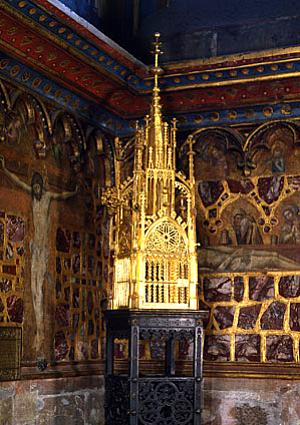
At any rate, had I attended Prague: The Crown of Bohemia 1347-1437 earlier I would’ve enjoined the reader to pay it a visit, but since it has finished its run I instead enjoin our dear readers to at least saunter down Fifth and stop to savor a glance of the cleaned-up Metropolitan sans banners. No doubt it will not be free of them for long — unless they who direct the Museum have had a moment of grace.
Previously: The Remarkable Hapsburgs | Brünn
Grande Journalerie
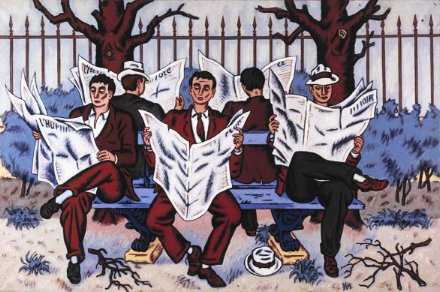
Jean Hélion, Grande Journalerie
Oil on canvas, 51″ x 76″
Robert Miller Gallery, New York
Old Men Playing Chess

Santiago de Chile, May 24, 2005. Photograph by Lucas de Soto.
Stained-Glass Window
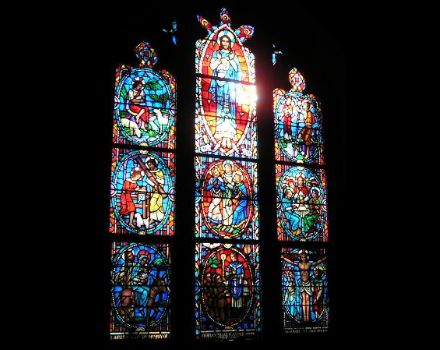
Here’s a window from the Goodhue-designed Christ Church Bronxville, with a close-up of one panel below.
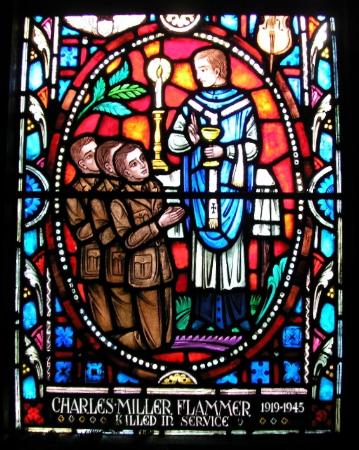
Recent New York Art
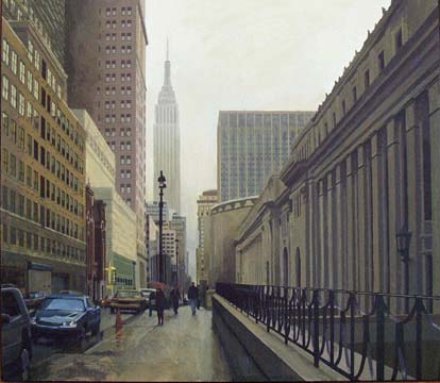
I am a philistine. The reason I am a philistine is because when it comes to art, I only like what I find beautiful. Today in the world of art, you’re supposed to appreciate art for the ideology and thought that goes behind it. If you only like what’s beautiful, then you are a philistine. I am quite happy being a philistine and hope I remain a philistine for the rest of my life.
Nonetheless, there have been a few recent works of art I felt I ought to show you. The common theme is New York. (more…)
The Dream of Christopher Columbus
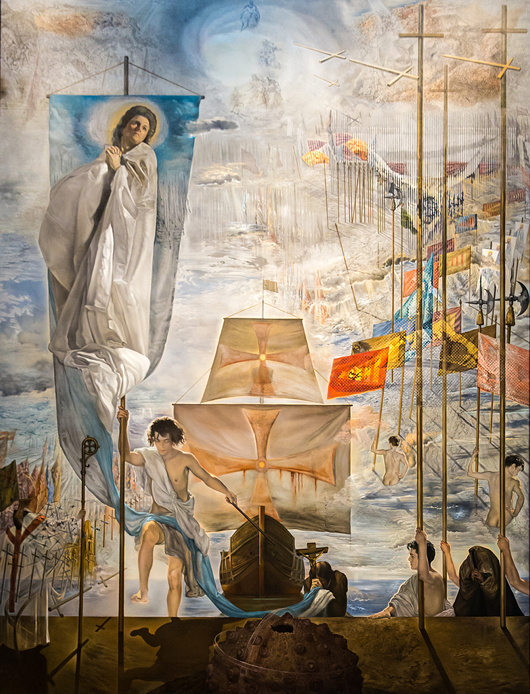
The Dream of Christopher Columbus, sometimes known as “Christopher Columbus Bringing Christianity to America”, by Dalí.
The two orbital paths in an armillary-like fashion around the sea urchin are taken to be a symbol for Man’s conquest of the Moon, which took place some years after the painting was finished.
Huntington Hartford commissioned the painting from Dalí for his Gallery of Modern Art which once stood in New York’s Columbus Circle.
The Death of Marat
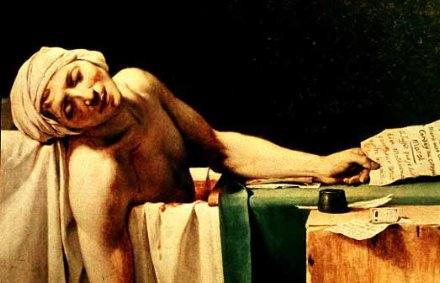
The thirteenth of July is also the day that the brave heroine of France, Charlotte Corday, killed the murderous revolutionary swine Jean-Paul Marat. Marat received his M.D. from St Andrews, and his villainy is remembered in the annual Kate Kennedy Procession, in which he is rightfully described as a “paranoid demagogue.”
The assasination inspired David to paint his famous depiction of the event. It is one of my favourite paintings, and a brilliant piece of propaganda portraying a bloodthirsty hatemonger as an angelic martyr.
Remembrance via the great Irish Elk.
Bo Bartlett, The Bride
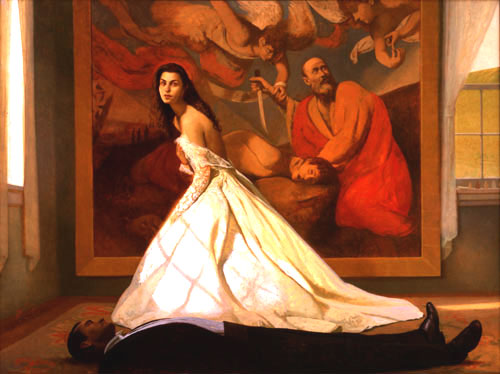
Bo Bartlett, The Bride
Oil on linen, 80″ x 100″
Private collection
Bo Bartlett, Leviathan
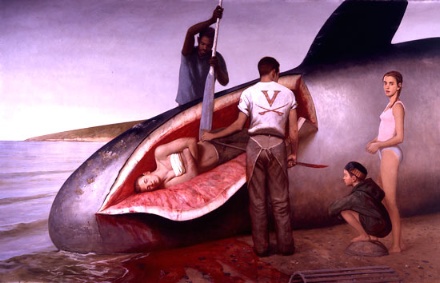
Bo Bartlett, Leviathan
Oil on linen, 89″ x 138″
Private Collection
Scott Fraser
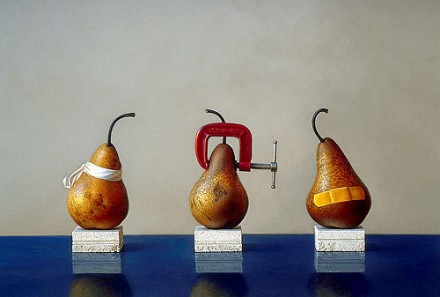
Scott Fraser, See No Evil, Hear No Evil, Speak No Evil
Oil on Board, 9″ x 17″
Private Collection
The University Maces
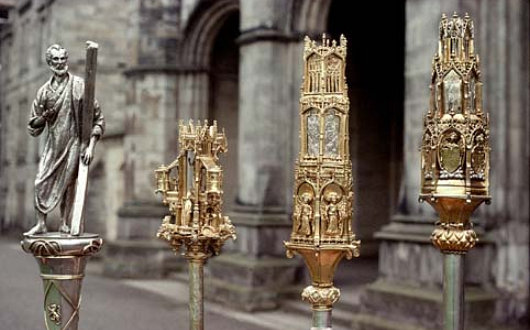
On my last day in St Andrews before summer break, Michelle Romero and I were lucky enough to finagle our way into a private showing of the University’s maces to the Kate Kennedy Club, organized by the Head Janitor & Bedellus, Jim Douglas, M.A. It was amazing. The metalwork on these maces (six in total) is so intricate and beautiful.
The late R.G. Cant said that if he had to put a value to the maces, Bishop Kennedy’s mace (made in 1461 in Paris) would be worth £10 million, and the mace of the Faculty of Arts would be £5 million, though in effect they are priceless. I have to admit it was nearly frightening to hold £10 million pounds in your hands.
It’s such a shame that the modern mace for the whole of the University (furtherst left in the photo) pales in comparison to the others, especially since it is the mace used at Chapel and thus the mace used most often. Mr. Douglas told us that the rod of the Rector’s mace (not pictured) is actually a broomstick painted black. Apparently, the Principal and Vice-Chancellor, Dr. Brian Lang, is going to have it replaced with a lengthened ebony rod.
Search
Instagram: @andcusack
Click here for my Instagram photos.Most Recent Posts
- Amsterdam November 26, 2024
- Silver Jubilee November 21, 2024
- Articles of Note: 11 November 2024 November 11, 2024
- Why do you read? November 5, 2024
- India November 4, 2024
Most Recent Comments
- on The Catholic Apostolic Church, Edinburgh
- on Articles of Note: 11 November 2024
- on Articles of Note: 11 November 2024
- on Why do you read?
- on Why do you read?
- on University Nicknames in South Africa
- on The Situation at St Andrews
- on An Aldermanian Skyscraper
- on Equality
- on Rough Notes of Kinderhook
Book Wishlist
Monthly Archives
Categories

